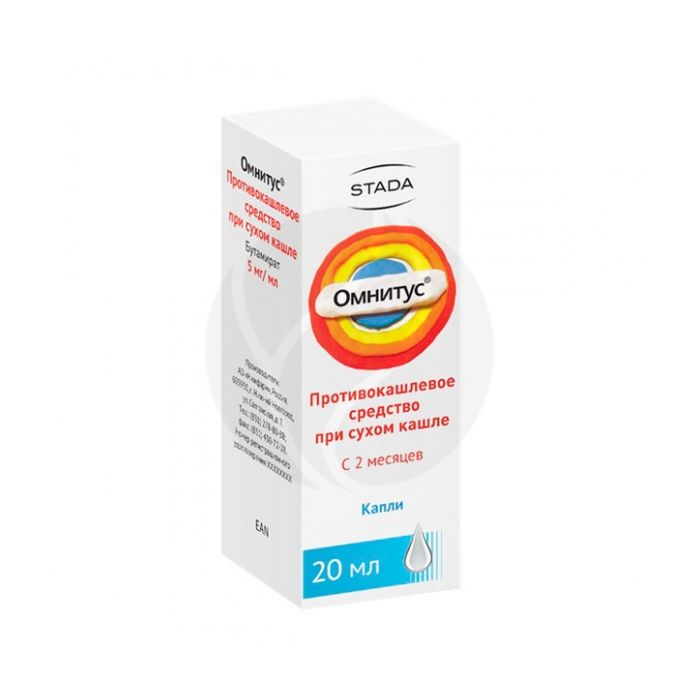Omnitus drops for oral administration 5mg / ml, 20ml
Expiration Date: 05/2027
Russian Pharmacy name:
Омнитус капли д/приема внутрь 5мг/мл, 20мл
Inside, before meals.
Children from 2 months to 1 year: 10 drops, 4 times a day; from 1 to 3 years: 15 drops, 4 times a day; 3 years and older: 25 drops, 4 times a day.
If the cough persists for more than 7 days, you should see a doctor.
Before using the drug in children under 2 years of age, consult a doctor
Drops for oral administration in the form of a transparent, colorless or yellowish solution with a characteristic odor.
1 ml
butamirate citrate 5 mg
Excipients: sorbitol 70% (non-crystallizing), glycerol, sodium saccharinate, benzoic acid, vanillin, ethyl alcohol 96%, sodium hydroxide, purified water.
Hypersensitivity to the components of the drug,
children's age up to 2 months,
pregnancy (I trimester),
breastfeeding period,
intolerance to fructose (the drug contains sorbitol),
simultaneous use with expectorant drugs.
Carefully
Pregnancy (II and III trimesters), in patients with a tendency to develop drug dependence, since the drug contains ethanol, impaired liver function, alcoholism, epilepsy, brain diseases, use in children under 2 years of age.
pharmachologic effect
Antitussive agent of central action. Butamirate does not belong to the opium alkaloids. Does not form addiction or addiction.
Suppresses cough by directly affecting the cough center. Has a moderate bronchodilatory effect. Helps facilitate breathing, improves spirometry (reduces airway resistance) and blood oxygenation.
Pharmacokinetics
After oral administration, butamirate is rapidly and completely absorbed, measured concentrations are found in the blood 5-10 minutes after ingestion.
Cmax in blood plasma is reached within 1 hour. Average plasma concentrations of 2-phenylbutyric acid are reached within 1.5 hours.
Butamirate has a large Vd in the range of 81-112 L (corrected for body weight in kg), as well as a high degree of binding to plasma proteins. 2-phenylbutyric acid has a high degree of binding to plasma proteins - on average 89.3 - 91.6%. Also, the ability of diethylaminoethoxyethanol to bind to plasma proteins is found, the average values ??vary in the range of 28.8% - 45.7%. It is not known whether butamirate crosses the placenta or is excreted in breast milk.
Hydrolysis of butamirate, which results in the formation of 2-phenylbutyric acid and diethylaminoethoxyethanol, which have an antitussive effect, occurs very quickly. 2-phenylbutyric acid undergoes further partial metabolism by hydroxylation in the para-position.
The excretion of the three metabolites occurs mainly through the kidneys; after conjugation in the liver, acidic metabolites are largely bound to glucuronic acid. Conjugates of 2-phenylbutyric acid are detected in urine at significantly higher concentrations than in blood plasma. Butamirate is found in urine within 48 hours. Butamirate is excreted in the urine in greater quantities in the form of diethylaminoethoxyethanol than butamirate in unchanged form or in the form of unconjugated 2-phenylbutyric acid.
The measured T1 / 2 of 2-phenylbutyric acid, butamirate and diethylaminoethoxyethanol is 23.26-24.42 h, 1.48-1.93 h and 2.27-2.90 h, respectively.
Side effect
From the side of the central nervous system: rarely - drowsiness, dizziness.
From the digestive system: rarely - nausea, vomiting, diarrhea.
From the side of the skin: rarely - exanthema.
Others: development of allergic reactions is possible.
Application during pregnancy and lactation
It is contraindicated for use in the first trimester of pregnancy and during lactation (breastfeeding). In the II and III trimesters of pregnancy, it is used with caution and only in cases where the expected benefit of therapy to the mother outweighs the potential risk to the fetus.
Application in children
Contraindication: children's age up to 2 months (for drops), up to 3 years (for syrup), up to 12 years (for modified-release tablets).
special instructions
In children, it should be used only in dosage forms that are specifically designed for this category of patients in accordance with age.
Influence on the ability to drive vehicles and mechanisms
Butamirate can cause drowsiness, therefore, during the period of treatment, patients should be careful when driving and other activities that require increased concentration of attention and speed of psychomotor reactions.
Drug interactions
Due to the fact that butamirate suppresses the cough reflex, the simultaneous use of expectorants should be avoided in order to avoid the accumulation of phlegm in the respiratory tract.
During the period of treatment with butamirate, the use of drugs that have a depressing effect on the central nervous system (including hypnotics, antipsychotic, tranquilizers) is not recommended.

